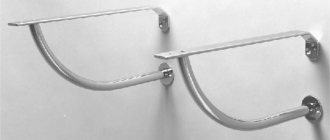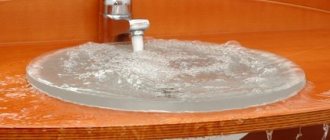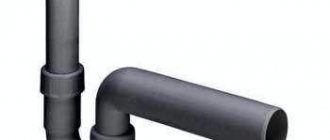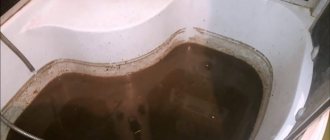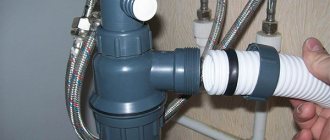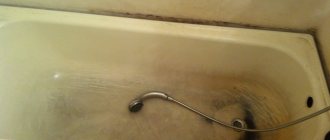Violation of tightness
At the junction of the siphon and the pipe, a leak is often observed. The occurrence of this problem is quite easy to determine (unlike blockages or internal breakdowns), since the result will be drips. If the problem has not been resolved at the time of its occurrence, these leaks cause a stench from the sink, the appearance of fungus and mold on the walls and floor. This happens when the seals are worn out or deteriorated. A temporary solution can be a special sealing tape or electrical tape, but new seals will help to finally solve the problem.
If a leak occurs between pipes, then it is necessary to coat their joints with silicone sealant.
Use of chemicals
The easiest way to clear a clogged kitchen sink is to use special chemicals. To do this, you do not need to have special knowledge and skills as a plumber. There is no need to disassemble the drainage system either. It is enough to purchase the necessary chemicals and hand protection products at the hardware store. Wearing gloves, pour the contents of the bag into the sink or pour out the liquid reagent.
After the time specified in the instructions for use, rinse the system with plenty of running water. In most cases, with mild blockages, this product does an excellent job. The following remedies have a good effect:
- Mole.
- Odorgon.
- Rowdy.
- Domestos.
In some cases, if the blockage is not too severe, the “Belizna” solution is sufficient. Factory reagents must be used according to the attached instructions. Since almost all of these products are highly toxic, it is necessary to protect yourself with gloves and a mask. The cost of such drugs may depend on their effectiveness and chemical composition.
If the sink is clogged or the pipes are damaged
If you have checked the correct installation of the structure and nothing has caused you any doubts, you can proceed to the next stage
You need to pay attention to the following points:
- Turn on the faucet in the kitchen and watch the water: if it does not drain immediately, but stagnates in the sink, it means a blockage has formed. It can be removed in several ways, the most popular of which is using a plunger. You need to turn on the water so that the bowl of the plunger is under water, attach it to the drain hole and make vertical movements. After a few minutes of such actions, you need to tear the plunger away from the hole and allow the stagnant water to drain back, the blockage will be cleared, and the sewer smell will disappear. The second option is to use special cleaning products; they can be bought at a hardware store. The substances included in their composition dissolve all the plaque that has accumulated on the walls of the pipes, from fat to hair.
- If the water drains normally, you need to check the integrity of the pipes and the correctness of their connections. If the pipe is cracked in some area, it must be replaced, but if the elements of the drain system are simply loosely screwed to each other, they need to be secured.
- If a characteristic squelching sound is heard from the drain and there are no signs of structural damage, the riser may be airy. Only housing and communal services employees can cope with this; it is impossible to solve this problem on their own.
The problem of sewage smell from the kitchen sink most often lies in the formation of plaque on the walls of the pipes. The easiest way to get rid of it is to call a plumber who can disassemble and wash all components of the drain system. But if you don’t want to spend money on his services, you can use the means at hand.
If you have a flask siphon installed, you need to unscrew it and clean it. Often an object gets stuck in it, on which other waste is subsequently layered. Thus, by removing all the impurities from the pipe, you can easily eliminate the smell from the sink.
There are also folk ways to solve the problem. First, you can remove the smell from your sink using baking soda. Mix three tablespoons of this product in a glass of warm water and pour this mixture down the drain. After half an hour, you need to turn on a stream of warm water to get rid of any remaining solution in the pipes. Secondly, you can use table vinegar by pouring it into the drain hole, which you then need to plug with a rag to prevent the smell of the product from spreading. Thirdly, you can use citric acid, pour boiling water over it and pour the mixture into the sink, and after half an hour rinse with a stream of warm water.
Watching the car wash
In some cases, you can deal with the bad smell from the sewer on your own. Let's figure out when you can do without calling a specialist from technical services.
First, let's watch the washing machine in action. You should pass a large volume of the hottest water possible; if it flows well, does not stagnate, but the smell does not become weaker, try flushing the drains with home remedies (recipes are given below in the article) or products containing aggressive chemical compounds.
If the problem is deposits and fat that have begun to emit a putrid odor, then you can deal with it.
If cleaning the pipes did not help, then we will carefully examine the siphon and the pipes underneath it. All parts of the sewer system must be dry; if there is a leak somewhere, it must be repaired.
The pipes must be intact, without chips, all connections must be free of wet marks. There is a mess - fum or plumbing sealant will come to the rescue.
Plumbing sealants that are suitable for the kitchen:
- acrylic;
- silicone;
- silicone-acrylic.
The most popular are silicone sealants , they are optimal for the kitchen - they have excellent bonding properties, withstand temperature changes, and retain moisture well. The disadvantages include the cost of the product.
Acrylic sealants are durable and more affordable, but due to their lack of elasticity, seams can become depressurized over time. Therefore, it is better to choose another option, or to vigilantly monitor the condition of all sewerage elements.
Silicone-acrylic sealants , as the name implies, combine the best qualities of the above sealants.
If we open the tap and observe, we will notice that the water is slowly draining, standing in the sink, and we have a blockage.
Unprofessional diagnosis of breakdowns
The first thing to do for this is to flush the pipes. The smell may disappear for a while and then reappear. This is a sure sign that the reasons are not just dirty walls. After this, you can observe the operation of the drain system, for which you must first remove all items from the cabinet under the sink. If the water does not drain immediately, but with some delay, or stagnates in the sink, this is a sign of a blockage. It can be eliminated with a plunger while it is small, or using special products, the most professional of which can dissolve not only fat, but even human hair. Long-term stagnation in the sink, which cannot be removed by either method, requires the help of a plumber and the use of special tools.
You can diagnose a breakdown of the sewer system in the sink using improvised means by examining the pipes
If the water drains normally, but makes characteristic squelching sounds, this means that the riser is airy. You shouldn’t think about what this means, because a simple kitchen worker will not be able to do this, nor will she be able to replace pipes in case of cracking or depressurization. You need to call your husband, and if he cannot cope with the scope of work, then a plumber. If a flask siphon is installed in the system, then with all its undeniable advantages it must be periodically unscrewed and cleaned. Perhaps it is its clogging that is the source of unpleasant odors.
An unpleasant odor may also appear if the sink has not been used for a long time, but this problem can be easily eliminated - before leaving for a while, pour a little sunflower oil into the sink, and upon arrival, start actively using the sink again. This will prevent the possibility of bacterial growth.
Not only unpleasant, but also harmful!
The point is not only that the heavy sewer spirit is unpleasant to all household members, it is also harmful. Human evolution has made sure that he can recognize odors that threaten his health. And a sharp, repulsive smell signals us about danger; we should not distrust our instincts.
Let's try to figure out why the smell from the sink is harmful? The air from the sewer, which enters our premises and causes our rejection, is poisonous. It contains hydrogen sulfide and ammonia fumes. During decomposition processes in the sewer system, methane is also formed, which also does not contribute to human health.
Together, these substances - methane, ammonia and hydrogen sulfide - negatively affect human health. Through the respiratory system they depress the central nervous system. In severe cases, they provoke nervous breakdowns and brief loss of consciousness.
Therefore, we strongly recommend removing the unpleasant smell under the sink as soon as you notice it!
How to eliminate smell from kitchen sink using home methods
- Use available means - salt, soda or vinegar. There is only one principle - leave the concentrated product for 2-5 hours, and then rinse everything with boiling water. The method is quite effective for eliminating greasy deposits on the inner walls of pipes. This procedure must be carried out regularly as a preventive measure to avoid small food debris from sticking to the siphon.
- A faulty water seal and the characteristic “bubbling” and “hissing” of water can be dealt with by having the simplest plumbing skills. Which in a matter of hours will level the slope of the pipes or replace the riser with pipes of larger diameter to prevent the formation of vacuum in the system.
- If the cause of the unpleasant odor lay in an unsuccessful model or incorrect installation of the siphon, then select larger equipment or reconnect the old one. If thread failures continue, then they resort to completely replacing this part of the drain and purchasing a new siphon.
Siphon disassembly
If the corrugated pipe begins to unbend over time and cracks form on it, then the use of insulating tape will be a temporary salvation from troubles. But this is a temporary procedure that will help for a few days before purchasing new material.
How to remove an unpleasant odor?
There are several ways to eliminate it.
Cable
A regular metal cable is not suitable. You need a special one, plumbing, at least 5 meters long. It is equipped with a brush or hook that can lift the clog. The handle is also specific: it allows you to rotate the cable.
To remove a garbage plug this way, you should:
- Clear access to the corrugation.
- Insert the cable into it to the maximum depth.
- Start “screwing” it with your hands until it reaches the blockage.
- Use a hook to pull out the debris or push the plug further.
- You can try to break up the blockage with a cable, moving it in different directions.
After manipulation, wash the cable and lubricate it with machine oil. Then roll it up and put it away.
plunger
It is used if you are completely sure that the siphon is clogged and there is no desire to disassemble it.
Necessary:
- Place the plunger cap over the drain and, opening the hot water tap, wait until it completely covers it.
- Close the tap and forcefully move the plunger up and down, then sharply pull it out along with part of the blockage.
- Turn on hot water and rinse the sink.
If you don’t have a plunger at home, you can repeat the same steps using a milk or juice carton, cutting off the top of the package.
Siphon
They disassemble the siphon only if they are completely sure that it is the cause of the unpleasant odor. The test will be the following procedure: you need to pull the corrugation out of the riser, lower it into a container, turn on the water and see if there is a leak. If it is missing, the siphon is disassembled and cleaned:
- First unscrew the bottom part. If this is not the problem, continue disassembling.
- Remove all nuts and carefully inspect the pipes.
- Remove the blockage.
- Rinse the siphon.
- Putting all the parts together.
When assembling, be sure to use the instructions; if you followed them, the sink should work normally.
Cleaners
They can be from improvised products or professional ones. The most popular:
- Salt. The whole glass is poured into the sink and filled with half a liter of boiling water. After 3 hours, hot water opens and the entire drain is washed.
- Soda with salt. The mixture is prepared in a 1:1 ratio, after which it is also poured into the drain. After half an hour, it is washed with boiling water and the procedure is repeated. If this does not help get rid of the smell, then another cleaning method is chosen.
- Vinegar with soda. Proportions: pour two large spoons of soda into the siphon and then pour a glass of vinegar there. The drain is closed with a stopper, and 10 minutes after the end of the reaction, it is thoroughly washed with boiling water.
- A packet of citric acid concentrate in powder form is poured into the drain and hot water is turned on. A reaction like vinegar and soda begins. The further algorithm is the same. Dry mustard can be a substitute for lemon powder.
- Professional products include chemicals for cleaning pipes: Mole, Domestos, Brawl, Odorgon, Mister Muscle, Sanox, Belizna. To rinse the siphon, you must follow the instructions and take into account that the powder is more active than the liquid.
First necessary steps
To eliminate an unpleasant odor, you will have to find its root cause, otherwise you can only reduce its intensity, but after a while it will grow again. If you look under the sink, you will see that there is a curved pipe going down from the sink, in some cases it is smooth, in others it is corrugated. This pipe is called a siphon, its design allows you to prevent the smell of sewerage from passing through the sink into your kitchen, but if it does pass through, it means that there is a problem in some part of the pipe.
Regardless of which siphon you have installed - flask or corrugated - the principle of their operation is the same. They should always contain the required amount of water; it plays the role of a sewer odor blocker. Its absence is the second reason for the appearance of odor. Troubleshooting methods depend on what happened to the pipes or siphon; there are several options:
- The corrugated pipe has lost its shape. This is a fairly common problem that can occur even if the pipe is installed correctly. From the very first day of operation, you need to secure it using special holders, so it will be protected from deformation. If you notice that the pipe is sagging, you need to temporarily secure it with insulating tape and purchase a new siphon. After installing it, the unpleasant smell will not bother you.
- An error was made when installing the siphon. Most often, if the pipe is installed independently, the assembly rules may not be taken into account. If you have a flask siphon installed, the problem may be in the pipe - one of the elements of the drain system that connects the sink bowl and the siphon. To return the dominance of pleasant aromas to the kitchen again, you need to adjust the position of the nozzle; it should be 2-3 cm deep in the water, but not touch the bottom of the flask.
- Long downtime. If you don't use your sink for months or years, the water in the trap evaporates and there's nothing left to contain the odors. In this case, removing them from the kitchen sink is very simple; you just need to flush more water into the sink, and after a while the liquid will do its job. If you know in advance that you will not use the sink for a long time, you need to pour a little sunflower oil into it before leaving, which will create a film that protects the water from evaporation.
Often the cause of problems with a kitchen sink is the installation of a drain system yourself. If you have never done this before, it is best to leave the job to a professional plumber and supervise him so that you can do it right later. In most cases, problems arise with corrugated siphons, so if this is what you have, it is recommended that you call a plumber to install the system. This will protect you not only from the possibility of sewer odor, but also from more serious problems, such as spills.
Prevention will save us from many problems.
As with many problems, it is easier to prevent than to solve. Therefore, in housekeeping it is better to adhere to the tactics of taking preventive measures.
- Be sure to buy a special mesh for drainage; it will prevent large fractions of food debris or cleaning products from going down the drain. But it is not recommended to pour even small food waste like coffee grounds or tea leaves down the sink.
- After using the sink, run hot water, this will prevent grease from settling on the walls of the sewer.
- Clean your drain monthly using home remedies (see recipes above) or household chemicals. This will allow you to keep your entire sewer system clean.
- Use only high-quality siphons that are easy to disassemble and assemble. It is better to entrust their installation to professionals.
- Monitor the condition of the joining seams and lubricate them every 3–4 months.
Causes of unpleasant odors
There can be many root causes, but the main one is a clogged siphon. This is the small curved part of the drain pipe that is located directly under the sink. Serves to maintain the water level in the bend and separate the air in the apartment and in the sewer pipe. Regardless of design, all siphons work the same.
Standard siphon
Usually, over time, in the pipes or siphon, and due to insufficient care of the system, a greasy coating forms, to which small particles of food waste stick.
Accumulation of food debris in the drain
In addition to the classic reasons, blockages and unpleasant odors can be caused by malfunctions of the siphon itself, high wear and cracking of plastic pipelines, loose threads of connections, failure of the water seal, holes in metal pipes, and an incorrectly designed drainage system under the sink.
Plaque in the plum
Related article:
Household chemicals against blockages and stench
Not knowing how to remove odor from the kitchen sink, many people prefer to mask it using laundry detergent or dishwashing gel. This measure only temporarily weakens the aromas, but does not completely remove them. After 2-3 days, the kitchen sink smells bad again.
Instead of experimenting with powder and gel, it is better to use special products - Mole, Sanox, Comet. Their advantage is ease of use and high cleaning effect.
Household chemicals have a high price compared to home remedies. In addition, clog cleaners have an unpleasant odor and require careful handling. Before pouring or pouring the product into the pipe, it is necessary to protect your hands with gloves, your respiratory and vision organs with a respirator and goggles.
Household chemicals are placed in the drain, left for 15-30 minutes depending on the instructions for the product, and then washed with plenty of hot water.
Possible installation errors
Errors during the installation of siphons can be as follows:
- The pipe is not immersed in the water correctly. This oversight is very common, because of this, an unpleasant aroma penetrates the room through the space between the walls of the siphon and the water.
- Tension when installing corrugated pipe. Plumbers who are not particularly skilled can also commit negligence.
- Shortened siphon partition. This causes the water seal to be too small, it periodically breaks and the water escapes. There is only one way to solve this problem - replace the siphon.
- The corrugated pipe was bent. In such a situation, you can bring it to its normal position and secure it with electrical tape. But this is only a temporary measure; in the future you need to buy a new pipe.
- Incorrect installation of the siphon (for example, upside down).
- Lack of plumbing maintenance. Prolonged stagnation of water can cause evaporation of water stagnant in the siphon. Namely, this liquid, which is constantly present in the device, does not allow bad odors to penetrate into the room from the sewer.
These situations are usually the main reasons for the formation of an unpleasant odor. Contamination of pipes can occur even during short-term operation of the pipeline. In these situations, not only a slight coating forms on it, but also real traces of rot and mold in the system, as well as various manifestations of bacterial activity.
An unpleasant smell from pipes in the bathroom can also occur if the diameter of the riser is too small. According to standards, it must be at least 11 centimeters. If this value is less, the passage of drains may be difficult, and this will cause blockages, which, in turn, will lead to the appearance of an unpleasant odor.
Why is sewer smell dangerous?
You should not be tolerant of the appearance of an unpleasant smell from the sewer. The stench that comes from sewer systems is not only downright stinky, but also harmful to your health.
This is usually the smell of hydrogen sulfide and ammonia, which, if regularly inhaled, can cause disruptions in the functioning of the human body, in particular, damage to the nervous and respiratory systems. Along with them, no less harmful methane enters the organ systems, aggravating the situation. Long-term exposure to these substances can cause imbalance or anxiety and even fainting.
Other options
In all cases when the sink smells like sewage, what to do in such a situation is decided step by step. Normal procedure:
- carefully inspect the outlet and siphon of the kitchen sink, there may be cracks or holes on them;
- run the water and check how fast it comes out of the sink;
- try to find the source of the odor by walking along the pipeline and determining which area the smell is strongest.
If there are no blockages, water comes out of the sink at a normal speed, but the smell still appears, you should look into the tightness of the sewer. The question often arises: why does air come out of the kitchen sink and smell like sewage? There are two options here:
- excess pressure of gases has been created in the internal volume of the pipelines, which breaks the water seal and escapes into the living quarters;
- During the volley discharge of wastewater, a strong vacuum was created, which broke the water seals inside the sewer system and opened the passage for gases into the apartment or house.
Both options have the same consequences, differing only in the direction of the water seal failure. There is a bad smell from the sewer in the kitchen, how to eliminate it by installing ventilation devices? The solution to the problem of excess pressure will be the creation of a vent pipe, allowing the excess volume of gases to escape into the atmosphere. This must be done by employees of the management company, since the waste pipe is a continuation of the sewer riser. This work requires organizing a passage through the roof, sealing the area and other complex and skilled work.
Installing a ventilation valve will help eliminate the vacuum in the sewer system caused by the volley discharge of water. This element can be installed independently; it is mounted on a horizontal section of the apartment sewer system. The device operates on the principle of a check valve - when a vacuum occurs, the valve opens and lets in air, balancing the pressure in the internal volume of the system. The disadvantage of this option is that the valve only works in one direction, i.e. unable to correct excess pressure. However, in most cases it is the installation of a ventilation valve that helps.
Basic methods of disposal
The solution to the problem will depend on the provoking factor. If the cause is determined correctly, then eliminating the unpleasant odor will not be difficult.
Drying humid environments
When purchasing an air conditioner, it is recommended to pay attention to models that have a delay function for turning off the fan after the device has already been turned off. This keeps the evaporator dry and prevents the creation of a high humidity environment and unpleasant odors.
If the air conditioner does not have such a function, then this procedure can be done independently. It is necessary to manually turn on the ventilation for 3-5 minutes and only then turn off the device. If installation is incorrect, you can only get rid of the smell and moisture by reinstalling the system.
Treatment
It is recommended to clean the air conditioner regularly to prevent dirt from accumulating inside the device.
Particular attention is paid to hard-to-reach places - the evaporator, since fungi and bacteria most often accumulate there
Specialists clean these areas using gas and foam. The method is not as effective as manual cleaning, but it helps to cope with the unpleasant odor. The most common means of treatment are gas, foam, liquid antiseptic and hand washing.
Gas
In order for disinfection with this type of antiseptic to give the desired result, preliminary preparation is required:
- turning on air circulation;
- An antiseptic cylinder is activated near the air intake hole and the room is closed for 10-15 minutes;
- airing the room.
This method is considered the simplest and less effective, so you should understand that after some time the device has been in operation, the smell will appear again.
Foamy
In this case, a balloon filled with foam is used, which must be released inside the device onto the ventilation and air conditioning elements. Then the air conditioner turns on, the heating of which causes the foam to expand and penetrate into hard-to-reach places. It will settle within 15-20 minutes.
This processing method is considered more effective than the previous one. The product penetrates inside the device, thereby killing pathogenic microorganisms. But there are cases when this method does not give the desired result.
Liquid
Special products are used to treat the air conditioner with liquid antiseptics. Do not use household chemicals, as they can harm the device. Special solutions help fight fungi and bacteria without harming the elements of the device.
The treatment is carried out with a spray gun, paying attention to the air duct channels and the air conditioning system. Vapors of the product are sucked in through the air intake when the device is turned on.
The solution will be ineffective if you do not first clean the inside of the air conditioner.
Manual flushing
This method is considered the most effective in combating unpleasant odors. The system is completely disassembled and cleaned. This will require professional help. The process will take a lot of time, but the guarantee of achieving the result will be 100%.
Installation of antibacterial filters
A universal solution to the problem is the installation of antibacterial filters. They help fight unpleasant odors and pathogens.
Photocatalytic
This type of filter is considered absolutely safe for humans. It absorbs any organic odors. It is based on titanium dioxide.
Plasma ionizer
The filter is made of metal plates, the voltage between them is several thousand volts. A big plus is that it does not require periodic replacement of internal filters.
Catechin
The filters contain a natural antiseptic - catechin, which prevents viruses from attaching to the surface, as it envelops them. Considered safe and effective.


